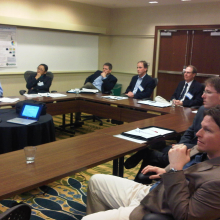Over 30 industry representatives participated in the 3rd Bi-annual CCSI IAB workshop, including management and technical personnel both from long-term and several new member companies. The CCSI Technical Team showcased recent advancements in the development of the CCSI Toolset and discussed ways the computational tools and models can help industry accelerate the development of carbon capture technology. In addition to reviewing technical progress, the CCSI Team described the Intellectual Property (IP) plan including the licensing structure, which will allow industry to begin testing early versions of the tools in the near future and will provide a route for long term commercialization. During the second day of the meeting, the IAB described their internal projects which could benefit from the use of the CCSI Toolset and discussed their current and planned collaborations with CCSI. Several new companies indicated plans to become more involved with the development and testing of the computational tools as a result of the workshop. Preliminary feedback from the IAB continues to indicate a favorable impression of the program’s progress and strong support for the overall approach. The meeting showcased CCSI technical accomplishments in 4 broad areas: (1) High Fidelity Models; (2) Process Systems; (3) Uncertainty Quantification; and (4) Risk Analysis. The meeting featured computer demonstrations, presentations and posters highlighting technical accomplishments, as summarized below.
(1) High Fidelity Models. We described our plans for hierarchically validating the CFD models. This approach will allow industry to readily make use of the CCSI models and adapt them to their own capture process. Results and insights from full scale simulations of a bubbling fluidized bed adsorber and a moving bed regenerator were discussed.
(2) Process Systems. We described the integrated suite of modular models developed to facilitate the design of carbon capture systems which include interaction with the power plant and compression system, and we showed how these modular models can be used for process synthesis to optimally determine process configurations. We also demonstrated new dynamic models for the capture and compression system and described how these models will be integrated with a power plant model. To highlight the generic applicability of the models, we demonstrated a new ability to link the CCSI process models with the Carbon Capture Materials Database (www.carboncapturematerials.org), developed by the Energy Frontier Research Center for Gas Separations Relevant to Clean Air Technologies. Another new capability demonstrated at the workshop was a web-based simulation architecture allowing thousands of simulations to be run concurrently, which significantly reduces the time for optimization and uncertainty quantification. Finally, we discussed a new oxy-combustion modeling activity consisting of an external collaboration with the University of Utah and an internal process modeling and optimization component.
(3) Uncertainty Quantification (UQ). The workshop started with a general introduction on UQ to provide background on this approach. During the breakout session, we highlighted how these tools can be applied to understand both model and parameter uncertainty. In addition, we demonstrated a graphical interface that links UQ tools with process simulation tools.
(4) Risk Analysis. We discussed our integrated decision model that incorporates financial risk with technical risk and technical maturity, including an estimate of the maturity of each process and the combined system level maturity.
CCSI is a partnership among national laboratories (NETL, LANL, LBNL, LLNL, PNNL), industry and academic institutions that is developing state-of-the-art computational modeling and simulation tools to accelerate the commercial development of carbon capture technologies. The meeting highlighted accomplishments achieved with funding from the broader ARRA Carbon Capture and Sequestration Simulation Initiative (C2S2I). (David C. Miller, 304-285-6550, Computational Science Division)

